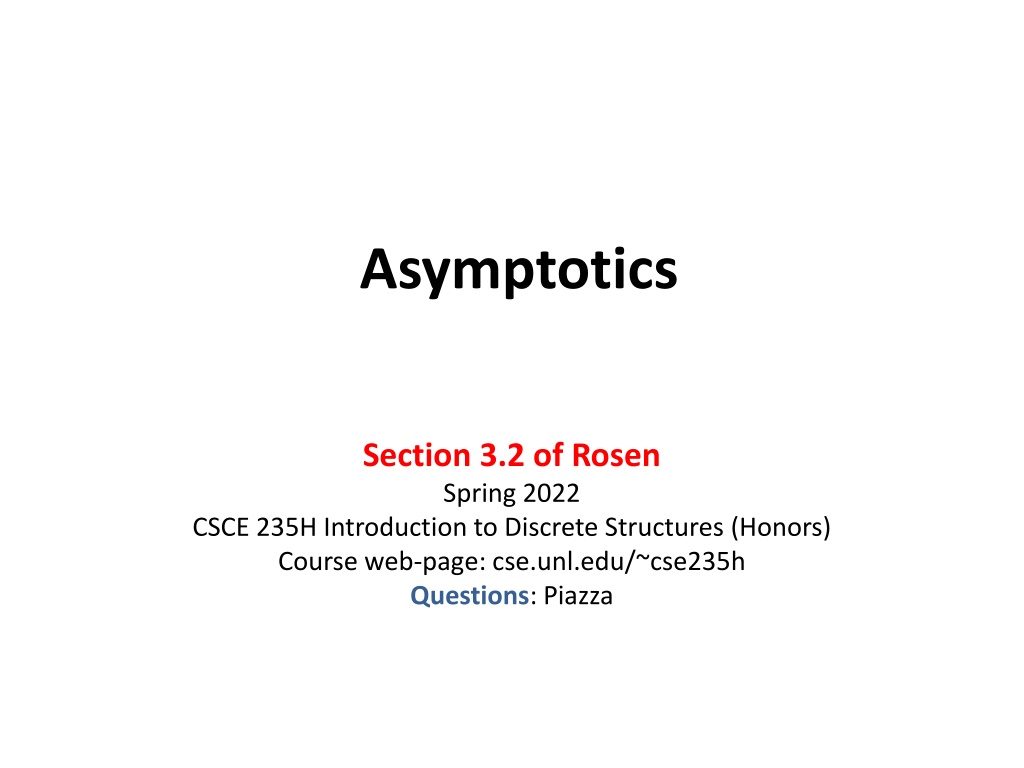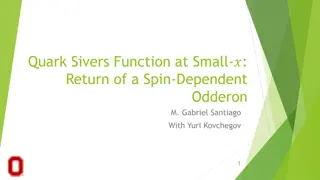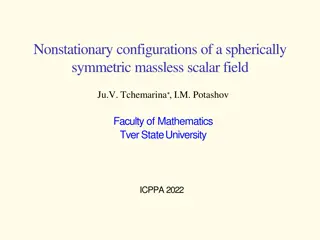
Understanding Asymptotic Behavior in Algorithms
Explore the concept of asymptotic behavior in algorithms, focusing on Big-O notation, complexity analysis, and algorithm performance scalability as input size grows. Discover how to evaluate algorithmic cost functions independently of specific hardware or implementation details.
Download Presentation

Please find below an Image/Link to download the presentation.
The content on the website is provided AS IS for your information and personal use only. It may not be sold, licensed, or shared on other websites without obtaining consent from the author. If you encounter any issues during the download, it is possible that the publisher has removed the file from their server.
You are allowed to download the files provided on this website for personal or commercial use, subject to the condition that they are used lawfully. All files are the property of their respective owners.
The content on the website is provided AS IS for your information and personal use only. It may not be sold, licensed, or shared on other websites without obtaining consent from the author.
E N D
Presentation Transcript
Asymptotics Section 3.2 of Rosen Spring 2022 CSCE 235H Introduction to Discrete Structures (Honors) Course web-page: cse.unl.edu/~cse235h Questions: Piazza
Outline Introduction Asymptotic Definitions (Big O, Omega, Theta), properties Proof techniques 3 examples, trick for polynomials of degree 2, Limit method (l H pital Rule), 2 examples Limit Properties Complexity of algorithms Conclusions 2 CSCE 235 Asymptotics
Introduction (1) In practice, specific hardware, implementation, languages, etc. greatly affect how the algorithm behave Our goal is to study and analyze the behavior of algorithms in and of themselves, independently of such factors We have seen how to mathematically evaluate the cost functions of algorithms with respect to their input size ? and their elementary operations 3 CSCE 235 Asymptotics
Introduction (2) However, it suffices to simply measure a cost function s asymptotic behavior We are interested only in the Order of Growth of an algorithm s complexity How well does the algorithm perform as the size of the input grows: n For example An algorithm that executes its elementary operation 10000ntimes is better than one that executes it 5n2times Also, algorithms that have running time n2and 2000n2are considered asymptotically equivalent 4 CSCE 235 Asymptotics
Introduction (3): Magnitude Graph 5 CSCE 235 Asymptotics
Outline Introduction Asymptotic Definitions (Big-O, Omega, Theta), properties Proof techniques Limit Properties Efficiency classes Conclusions 6 CSCE 235 Asymptotics
Big-O Definition Definition: Let f and g be two functions f,g:N R+. We say that f(n) O(g(n)) (read: f is Big-O of g) if there exists a constant c R+ and an no N such that for every integer n n0we have f(n) cg(n) Big-O is actually Omicron, but it suffices to write O Intuition: f is asymptotically less than or equal to g Big-O gives an asymptotic upper bound \mathcal{O} 7 CSCE 235 Asymptotics
Big-Omega Definition Definition: Let f and g be two functions f,g: N R+. We say that f(n) (g(n)) (read: f is Big-Omega of g) if there exists a constant c R+ and an no N such that for every integer n n0we have f(n) cg(n) Intuition: f is asymptotically greater than or equal to g Big-Omega gives an asymptotic lower bound \Omega() 8 CSCE 235 Asymptotics
Big-Theta Definition Definition: Let f and g be two functions f,g: N R+. We say that f(n) (g(n)) (read: f is Big-Theta of g) if there exists a constant c1, c2 R+ and an no N such that for every integer n n0we have c1g(n) f(n) c2g(n) Intuition: f is asymptotically equal to g f is bounded above and below by g Big-Theta gives an asymptotic equivalence \Theta () 9 CSCE 235 Asymptotics
Asymptotic Properties (1) Theorem: For f1(n) O(g1(n)) and f2(n) O(g2(n)), we have f1(n) + f2(n) O( max{g1(n), g2(n)} ) This property implies that we can ignore lower order terms. In particular, for any polynomial with degree k such as p(n)=ank+ bnk-1 + cnk-2 + , p(n) O(nk) More accurately, p(n) (nk) In addition, this theorem gives us a justification for ignoring constant coefficients. That is for any function f(n) and a positive constant c cf(n) (f(n)) 10 CSCE 235 Asymptotics
Asymptotic Properties (2) Some obvious properties also follow from the definitions Corollary: For positive functions f(n) and g(n) the following hold: f(n) (g(n)) f(n) O(g(n)) f(n) (g(n)) f(n) O(g(n)) g(n) (f(n)) The proof is obvious and left as an exercise 11 CSCE 235 Asymptotics
Outline Introduction Asymptotic Definitions (big O, Omega, Theta), properties Proof techniques 3 examples, trick for polynomials of degree 2 Limit method (l H pital Rule), 2 examples Limit Properties Efficiency classes Conclusions 12 CSCE 235 Asymptotics
Asymptotic Proof Techniques Proving an asymptotic relationship between two given function f(n) and g(n) can be done intuitively for most of the functions you will encounter; all polynomials for example However, this does not suffice as a formal proof To prove a relationship of the form f(n) (g(n)), where is , , or , can be done using the definitions, that is Find a value for c (or c1and c2) Find a value for n0 (But the above is not the only way.) 13 CSCE 235 Asymptotics
Asymptotic Proof Techniques: Example A Example: Let f(n)=21n2+n and g(n)=n3 Our intuition should tell us that f(n) O(g(n)) Simply using the definition confirms this: 21n2+n cn3 holds for say c=3 and for all n n0=8 So we found a pair c=3 and n0=8 that satisfy the conditions required by the definition QED In fact, an infinite number of pairs can satisfy this equation 14 CSCE 235 Asymptotics
Asymptotic Proof Techniques: Example B (1) Example: Let f(n)=n2+n and g(n)=n3. Find a tight bound of the form f(n) (g(n)) Our intuition tells us that f(n) O(g(n)) Let s prove it formally 15 CSCE 235 Asymptotics
Example B: Proof If n 1 it is clear that 1. n n3and 2. n2 n3 Therefore, we have, as 1. and 2.: n2+n n3 + n3 = 2n3 Thus, for n0=1 and c=2, by the definition of Big-O we have that f(n)=n2+n O(g(n3)) 16 CSCE 235 Asymptotics
Asymptotic Proof Techniques: Example C (1) Example: Let f(n)=n3+4n2 and g(n)=n2. Find a tight bound of the form f(n) (g(n)) Here, 0ur intuition tells us that f(n) (g(n)) Let s prove it formally 17 CSCE 235 Asymptotics
Example C: Proof For n 1, we have n2 n3 For n 0, we have n3 n3 + 4n2 Thusn 1, we have n2 n3 n3 + 4n2 Thus, by the definition of Big- , for n0=1 and c=1 we have that f(n)=n3+4n2 (g(n2)) 18 CSCE 235 Asymptotics
Asymptotic Proof Techniques: Trick for polynomials of degree 2 If you have a polynomial of degree 2 such as ??2+ ?? + ? you can prove that it is (?2) using the following values 1. ?1=? 2. ?2= 7? 4 4 |?| ?) 3. ?0= 2 max(|?| ?, 19 CSCE 235 Asymptotics
Outline Introduction Asymptotic Definitions (big O, Omega, Theta), properties Proof techniques 3 examples, trick for polynomials of degree 2, Limit method (l H pital Rule), 2 examples Limit Properties Efficiency classes Conclusions 20 CSCE 235 Asymptotics
Limit Method: Motivation Now try this one: f(n)= n50+12n3log4n 1243n12 + 245n6logn + 12log3n logn g(n)= 12 n50 + 24 log14 n43 logn/n5 +12 Using the formal definitions can be very tedious especially one has very complex functions It is much better to use the Limit Method, which uses concepts from Calculus 21 CSCE 235 Asymptotics
Limit Method: The Process Say we have functions f(n) and g(n). We set up a limit quotient between f and g as follows Then f(n) O(g(n)) Then f(n) (g(n)) 0 c>0 ?(?) ?(?) = limn Then f(n) (g(n)) The above can be proven using calculus, but for our purposes, the limit method is sufficient for showing asymptotic inclusions Always try to look for algebraic simplifications first If ? and ? both diverge or converge on zero or infinity, then you need to apply the l H pital Rule 22 CSCE 235 Asymptotics
(Guillaume de) LHpital Rule Theorem (L H pital Rule): Let f and g be two functions, if the limit between the quotient ?(?) ?(?) exists, Then, it is equal to the limit of the derivative of the numerator and the denominator ?(?) ?(?) = limn ? (?) ? (?) limn 23 CSCE 235 Asymptotics
Useful Derivatives Some useful derivatives that you should memorize ?? = ??? 1 1 log?(?) = ???(?) (product rule) careful! 24 CSCE 235 Asymptotics
Useful log Identities Change of base formula: 25 CSCE 235 Asymptotics
LHpital Rule: Justification (1) Why do we have to use L H pital s Rule? Consider the following function Clearly sin 0=0. So you may say that when x 0, f(x) 0 However, the denominator is also 0, so you may say that f(x) Both are wrong 26 CSCE 235 Asymptotics
LHpital Rule: Justification (2) Observe the graph of f(x)= (sin x)/x = sinc x 27 CSCE 235 Asymptotics
LHpital Rule: Justification (3) Clearly, though f(x) is undefined at x=0, the limit still exists Applying the L H pital Rule gives us the correct answer lim x 0 ((sin x )/x) = lim x 0 (sin x ) /x = cos x/1 = 1 28 CSCE 235 Asymptotics
Limit Method: Example 1 Example: Let f(n) =2n, g(n)=3n. Determine a tight inclusion of the form f(n) (g(n)) What is your intuition in this case? Which function grows quicker? 29 CSCE 235 Asymptotics
Limit Method: Example 1Proof A Proof using limits 2? 3? ?(?) ?(?) = lim We set up our limit: lim ? ? Using L H pital Rule gets you nowhere 2? 3?= lim 2? (3?) = lim ??2.2? ??3.3? lim ? ? ? Both the numerator and denominator still diverge. We ll have to use an algebraic simplification 30 CSCE 235 Asymptotics
Limit Method: Example 1Proof B 2? 3?= limn (2/3)n Using algebra lim ? Now we use the following Theorem w/o proof if < 1 if = 1 if > 1 0 limn n = 1 Therefore we conclude that the limn (2/3)n converges to zero thus 2n O(3n) 31 CSCE 235 Asymptotics
Limit Method: Example 2 (1) Example: Let f(n) =log2n, g(n)=log3n2. Determine a tight inclusion of the form f(n) (g(n)) What is your intuition in this case? 32 CSCE 235 Asymptotics
Limit Method: Example 2 (2) We prove using limits We set up out limit limn f(n)/g(n) = limn log2n/log3n2 = limn log2n/(2log3n) Here we use the change of base formula for logarithms: logxn = logy n/logy x Thus: log3n = log2n / log23 33 CSCE 235 Asymptotics
Limit Method: Example 2 (3) Computing our limit: limn log2n/(2log3n) = limn log2n log23 /(2log2n) = limn (log23)/2 = (log23) /2 0.7924, which is a positive constant So we conclude that f(n) (g(n)) 34 CSCE 235 Asymptotics
Outline Introduction Asymptotic Definitions (big O, Omega, Theta), properties Proof techniques 3 examples, trick for polynomials of degree 2, Limit method (l H pital Rule), 2 examples Limit Properties Efficiency classes Conclusions 35 CSCE 235 Asymptotics
Limit Properties A useful property of limits is that the composition of functions is preserved Lemma: For the composition of addition, subtraction, multiplication and division, if the limits exist (that is, they converge), then limn f1(n) limn f2(n) = limn (f1(n) f2(n)) 36 CSCE 235 Asymptotics
Complexity of AlgorithmsTable 1, page 226 Constant Logarithmic Linear Polylogarithmic Quadratic Cubic Polynominal Exponential Factorial O(1) O(log (n)) O(n) O(logk (n)) O(n2) O(n3) O(nk) for any k>0 O(kn), where k>1 O(n!) 37 CSCE 235 Asymptotics
Conclusions Evaluating asymptotics is easy, but remember: Always look for algebraic simplifications You must always give a rigorous proof Using the limit method is (almost) always the best Use L H pital Rule if need be Give as simple and tight expressions as possible 38 CSCE 235 Asymptotics
Summary Introduction Asymptotic Definitions (big O, Omega, Theta), properties Proof techniques 3 examples, trick for polynomials of degree 2, Limit method (l H pital Rule), 2 examples Limit Properties Efficiency classes Conclusions 39 CSCE 235 Asymptotics




